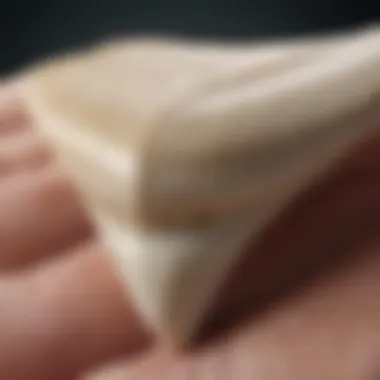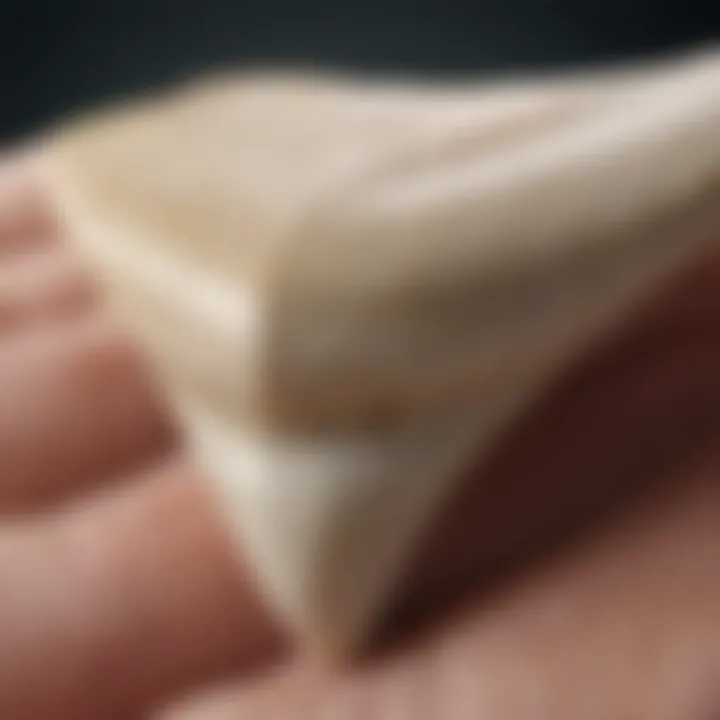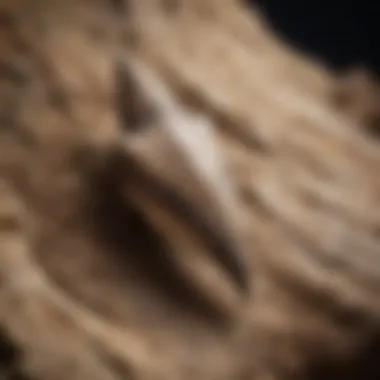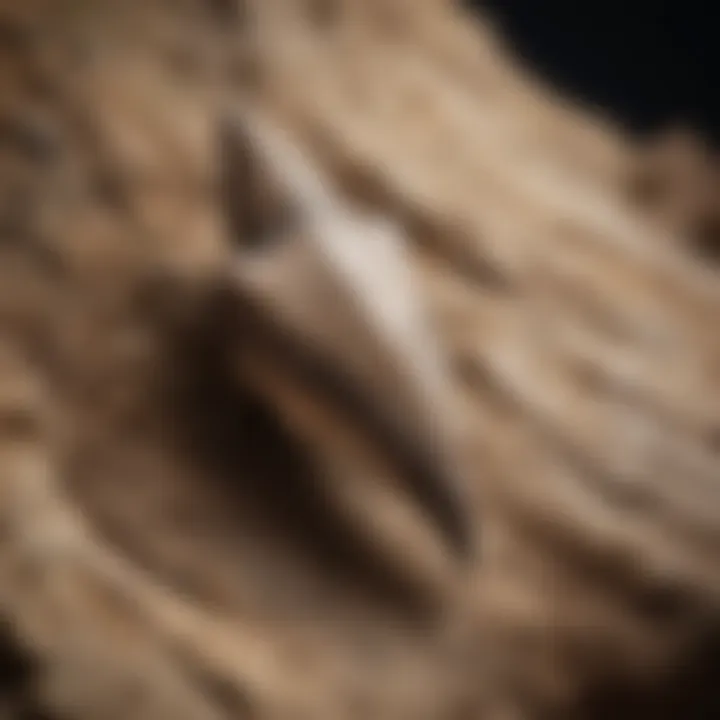Shark Teeth Identifier: A Guide to Identification


Intro
Shark teeth have fascinated collectors and scientists alike for centuries. These durable remnants of predatory ancient creatures speak volumes about the marine ecosystems of the past. Understanding how to identify and classify these teeth is essential for both novice and experienced collectors. This guide aims to provide essential knowledge on how to recognize different species of shark teeth and appreciate their significance.
History and Origins
Shark teeth have been found in sediments dating back millions of years. The geological layers in which they are discovered can tell much about their lineage and the environment during their existence. Fossil records indicate that sharks have been around for over 400 million years. It is remarkable to think how these teeth have survived the test of time, providing insight into the evolution of these apex predators.
Overview of Collectibles, Rocks, and Fossils
The hobby of collecting shark teeth is part of a broader interest in paleontology and geology. Fossil hunting can occur on beaches, riverbeds, and other locations where sedimentation has preserved these natural artifacts. Collectors often search for teeth from notable sharks like the Megalodon or the Great White. Each tooth has unique characteristics, such as size and shape, which help identify the species it came from.
Historical Significance and Cultural Impact
Throughout history, various cultures have revered shark teeth. In some Polynesian societies, shark teeth are considered symbols of strength and bravery. The use of these teeth in jewelry or tools is a testament to their cultural value. As more people engage in fossil collecting, the appreciation of shark teeth continues to grow, serving as a bridge between ancient marine life and contemporary understanding of ecology and evolution.
Identification and Classification
Identifying shark teeth requires attention to detail. Color, size, and shape play significant roles in classification. Properly identifying a tooth can provide insights into its origin and the habitat of the shark it belonged to.
Guide to Identifying Rocks and Fossils
When searching for shark teeth, recognizing the surrounding geological context is vital. Not all environments will yield shark teeth, and knowing where to look enhances chances of finding them. Areas with sedimentary rocks or marine fossils are often fruitful locations. Identifying general features can help collectors discern between different types of teeth. Some key aspects include:
- Size: Teeth can vary from a few millimeters to over seven inches.
- Shape: Look for distinct features, such as serrations or smooth edges.
- Color and Texture: Fossilized teeth may display a variety of colors based on mineral content.
Common Types and Variations
Different shark species leave behind distinctive dental structures. Some common types include:
- Megalodon Teeth: Characterized by their enormous size and broad serrations.
- Tiger Shark Teeth: Recognizable by their deep, curved shape and prominent serrations.
- Hammerhead Shark Teeth: Often smaller with various shapes, depending on species.
Understanding these differences is crucial for proper identification. Collectors may also benefit from comparative analysis using pictures or reference materials.
"Identifying shark teeth is both an art and a science, requiring practice and patience."
In summary, shark teeth serve as a window into the rich history of marine life. By understanding their origins and classification, collectors can deepen their appreciation and contribute to marine ecological awareness.
Preface to Shark Teeth
Shark teeth are an often overlooked aspect of paleontology. These small, yet significant, fragments of history offer valuable insights into both the evolutionary journey of sharks and the marine ecosystems they inhabited. This article delves into the fascinating world of shark teeth, providing readers with a comprehensive guide to identifying various types and understanding their importance.
The Importance of Shark Teeth in Paleontology
Shark teeth play a crucial role in paleontology due to their abundant fossil records. Unlike other marine creatures, sharks lack bones, making their teeth the primary source of information about their species. Each tooth type provides a unique window into the behaviors, diets, and habitats of these ancient fish. By studying shark teeth, researchers can glean insights about the ocean's historical food chains and climatic conditions.
Additionally, fossils help to establish timelines of species evolution. As scientists analyze the morphology of these teeth, they can track changes over epochs, revealing the adaptability and diversification of sharks through millions of years. This adaptability highlights the significant role sharks have played in maintaining ocean health despite environmental shifts.
An Overview of Shark Species and Their Teeth
The diversity of shark species is mirrored in the variety of their teeth. Each species has evolved distinct tooth forms suited to their feeding habits and ecological niches. For example, the Great White Shark possesses serrated teeth designed for tearing flesh, while the Tiger Shark has more robust teeth, ideal for crushing prey.


Understanding these differences allows enthusiasts and researchers alike to identify and classify shark teeth more effectively. Here are some notable shark species and their correlation with tooth morphology:
- Great White Shark: Renowned for its large, triangular, serrated teeth, essential for a predatory lifestyle.
- Tiger Shark: Known for its broad, flat teeth that assist in crushing shells.
- Hammerhead Shark: Features unique, specialized teeth adapted to their hunting style.
- Mako Shark: Recognized for its pointed teeth, which are efficient for capturing agile fish.
By examining the shape, size, and structure of shark teeth, collectors can gain a deeper understanding of the specific species and their ecological roles. This understanding is invaluable for appreciating the historical context of each tooth and its implications for marine biodiversity.
Classification of Shark Teeth
Understanding the classification of shark teeth plays a critical role in the study and identification of these remarkable fossils. The classification is not merely a matter of categorization; it provides insights into the feeding habits, evolutionary history, and ecological roles of various shark species. By distinguishing between different tooth types, collectors can understand the functional morphology of sharks. Such knowledge enhances enthusiasm for fossil collecting among hobbyists and professionals alike, allowing for a more profound appreciation of the specimens they encounter.
Morphological Features of Shark Teeth
The morphological features of shark teeth are paramount for identifiying species. Each tooth type reflects the dietary preferences and hunting strategies of the respective shark species. For instance, the shape, size, and serration of the teeth can indicate whether a shark feeds on fish, crustaceans, or other marine life. The examination of these features not only aids in the identification process but also establishes connections between the species and their environments. Collectors who are well-versed in these features are in a better position to discern the nuances in their finds, leading to more successful identification outcomes.
Types of Shark Teeth
Shark teeth are classified into several types based on their shape and functional characteristics. Each type serves a unique purpose in the feeding habits of sharks, hence understanding them is vital for both identification and insight into shark behavior.
Flat Teeth
Flat teeth are designed primarily for crushing and grinding. These teeth often belong to species that feed on hard-shelled prey such as mollusks or crabs. A key characteristic of flat teeth is their broad, plate-like structure. This design allows sharks to apply significant pressure and efficiently break open shells. In the realm of fossil collecting, flat teeth are relatively common and can be identified by their smooth surfaces and worn edges. However, they may not be as visually striking as other types, which can make them less popular among collectors.
Pointed Teeth
Pointed teeth are sharp and slender, enabling sharks to grip slippery prey like fish. The defining feature of pointed teeth is their sharp edge, which helps in piercing flesh. These teeth are crucial for species that rely on speed and precision to catch quick-moving prey. Collectors often favor pointed teeth because their streamlined shape adds an aesthetic appeal to displays. Nevertheless, their rarity can sometimes make them more challenging to find.
Cusped Teeth
Cusped teeth combine elements of both pointed and flat teeth. They often feature a prominent cusp that aids in holding onto prey while also providing the ability to slice. This type of tooth is typically found in species that have varied diets. A significant advantage of cusped teeth for collectors is their distinctive shape, which allows for intriguing showcases. However, their identification can sometimes be complex due to their intermediate characteristics, requiring careful examination to distinguish them from other types.
Triangular Teeth
Triangular teeth are characterized by their broad base and pointed tip, resembling a triangle when viewed from above. This shape is ideal for slashing through flesh, making it prevalent among larger predatory sharks. The triangular structure provides an excellent balance of cutting power and durability. Because of their impressive appearance, triangular teeth are often sought after by collectors. However, they can be abundant in certain areas, which might lessen their collectible value.
Popular Shark Species and Their Teeth
Understanding popular shark species and their teeth is crucial for anyone interested in shark tooth identification. Each species has distinct dental features that reflect their feeding habits and ecological roles. Recognizing these differences aids collectors in identifying the origins of the teeth they find. This section will focus on some of the most recognized species, detailing their unique tooth structures and the implications for collectors.
Great White Shark Teeth
The Great White Shark is one of the most iconic shark species. Its teeth are large and triangular, designed for slicing through flesh. These teeth may grow up to 3 inches in length, with serrated edges that enhance their cutting efficiency. The shape allows the Great White to capture and grip prey effectively, such as seals and large fish. Collectors often seek Great White teeth due to their impressive size and the status of the species in marine ecosystems. When identifying these teeth, look for the characteristic triangular shape and serration patterns.
Tiger Shark Teeth
Tiger sharks possess a more specialized tooth structure compared to the Great White. Their teeth are often described as having a more rounded and pointed tip, making them ideal for crunching through hard-shelled prey such as turtles and crustaceans. The teeth can vary significantly in size but are typically around 1 to 2 inches long. Coloration can range from grey to brown, and many have distinctive stripes, reflecting their name. Recognizing Tiger Shark teeth involves noting the unique shape and texture, which includes a somewhat flattened form.
Mako Shark Teeth
Mako sharks, known for their speed and agility, have teeth that assist in their hunting style. Their teeth are long and pointed, which helps them grasp slippery prey. Mako teeth generally will have a narrower profile than those of the Tiger Shark and can reach about 1 to 2 inches in length. They are less robust, reflecting their diet of fast-moving fish. Collectors often find Mako teeth intriguing because of their sleek design and the shark's reputation as one of the fastest sharks in the ocean. When identifying, pay close attention to the pointed shape and minimal serration, as these are hallmarks of the Mako.
Hammerhead Shark Teeth
The Hammerhead Shark is recognized not only for its unique head shape but also for its teeth. These teeth are typically more square or rectangular, which is somewhat atypical compared to other shark species. The shape helps in pinning down prey like stingrays. Hammerhead teeth can be up to 1.5 inches long, and collectors appreciate their distinct appearance. When identifying Hammerhead teeth, focus on the anti-predation features, such as the broader surface that allows better grip. Collectors should note that there may be variations in shape among the several species of Hammerheads, making close scrutiny essential.


"Each shark tooth tells a story about its owner and its environment."
Identifying Shark Teeth
Identifying shark teeth is a critical skill for enthusiasts and collectors alike. The intricate details of each tooth tell us more than what meets the eye; they reveal the diversity of marine life and the surrounding ecosystems. Moreover, a well-identified shark tooth can serve as a meaningful reference point for scientific study and conservation efforts. Understanding the methodical approach to identification not only enhances appreciation but also promotes responsible collection practices. An accurate identification can also help differentiate between common and rare species, impacting both value and conservation discussions.
Step-by-Step Identification Process
The identification process for shark teeth involves a systematic approach. It is important to follow logical steps to ensure accuracy. First, one should inspect the overall size of the tooth. Different shark species have distinctly sized teeth that offer valuable clues. Next, assess the shape. Teeth can be flat, pointed, or triangular, which are linked directly to the feeding habits of different sharks. After that, consider the coloration, as certain species exhibit specific color patterns. Finally, cross-reference these identifiers with known examples to confirm the species. By practicing these steps, collectors can become skilled in distinguishing between various types of shark teeth.
Tools for Identification
Magnifying Glass
A magnifying glass is an essential tool for detailed examination. It allows collectors to scrutinize fine details like serrations and markings on the teeth. These details are critical for identifying species accurately. The key characteristic of a good magnifying glass is its clarity. A clear image makes it easier to observe subtleties that the naked eye might miss. This tool is widely regarded among collectors due to its accessibility and effectiveness in providing close-up views of the teeth. However, some may find that it lacks the ability to illuminate the tooth, limiting visibility in low-light conditions.
Reference Guides
Reference guides are invaluable resources that compile information about various shark tooth species. These books or manuals often include high-quality images and detailed descriptions, making them a beneficial choice for identification. They serve as a quick reference point during fieldwork or collection assessments. The unique feature of reference guides is their comprehensive coverage, which enables users to compare their specimens to established standards. On the downside, some guides may be outdated, which can lead to misidentifications if recent species discoveries are not included.
Digital Resources
Digital resources are increasingly popular among shark tooth enthusiasts. Websites and apps dedicated to marine biology and fossil collections provide a wide array of information quickly and conveniently. The key characteristic of digital resources is their ability to be updated frequently, ensuring users have access to the latest data. This immediacy of information makes them beneficial for real-time identification. However, one limitation is the reliance on internet access, which can be a barrier in remote locations where many collectors search for teeth.
The combination of physical tools and digital resources creates a robust framework for anyone looking to improve their shark tooth identification skills.
Collecting Shark Teeth
Collecting shark teeth is an engaging activity for enthusiasts of all levels. It provides insight into marine biology, geology, and paleontology. Each tooth found tells a part of the story of the ocean's past, making it a rewarding pursuit. The variety of shark species makes their teeth distinctive and valuable for collectors. This section highlights important aspects such as legal and ethical considerations, as well as the best locations to find these unique artifacts.
Legal and Ethical Considerations
When collecting shark teeth, it is vital to understand the laws governing fossil collection. Many regions have regulations that protect not only the fossils themselves but also the habitats where they are found. Collectors must research local laws before embarking on their collecting endeavors. It enhances the experience when collectors respect nature and preserve these natural resources for future generations. In addition, ethical collecting practices should be followed. This means not disturbing nesting sites, respecting the environment, and only collecting what is permitted.
Finding Shark Teeth: Best Locations
Finding shark teeth can be quite thrilling. Several top spots exist where collectors can search for these treasures. Here are some notable locations:
Coastal Areas
Coastal areas are a popular choice for shark teeth hunting. Beaches often experience erosion, which can expose buried teeth. Collectors can sift through sand and gravel near tidal zones, increasing their chances of discovering teeth. One key aspect of coastal areas is their accessibility. Many beaches are easy to reach, making them suitable for casual collectors. However, a drawback is that the selection may be limited, as many previous collectors frequent these spots.
Fossil Beds
Fossil beds provide a rich hunting ground for collectors. These locations often yield diverse types of teeth, providing opportunities for unique finds. The key characteristic of fossil beds is their geological history. Layers of sediment can reveal ancient ecosystems, including the remains of long-extinct shark species. Collecting here can be rewarding, but caution is necessary. Some fossil beds are in protected areas, and collecting might be prohibited. Always check regulations ahead of time.
Riverbanks
Riverbanks are another promising venue for locating shark teeth. Rivers often expose fresh deposits due to flowing water and sediment movement. Collectors may find teeth that have washed down from upstream locations. The dynamic nature of riverbanks means that what one finds can change frequently. This aspect keeps the collection experience exciting. However, safety should be a priority, as the banks can be unstable and sometimes treacherous.
By understanding the best locations and considering legal and ethical guidelines, collectors can enhance their experience and contribute positively to the field. Shark teeth collecting is not just a hobby—it is a connection to the environment and a deeper understanding of marine life.
Preservation and Care of Shark Teeth


Preserving and caring for shark teeth is an essential aspect for collectors and enthusiasts. These artifacts hold not only intrinsic value but also historical significance. Proper care ensures that these teeth retain their structural integrity and aesthetic appeal over time. Many collectors find it necessary to maintain their specimens in optimal condition, as environmental factors can lead to deterioration. Factors such as humidity, temperature fluctuations, and exposure to sunlight can significantly affect the condition of these natural treasures.
By implementing appropriate preservation strategies, collectors can enhance their ability to study and showcase these teeth without risking damage. Understanding how to clean them correctly and store them safely is crucial. Certain methods of maintenance can prevent discoloration, breakage, or the accumulation of debris. Ultimately, preserving shark teeth can also contribute to a better understanding of their role in marine ecology, making this a vital area of focus.
Cleaning Techniques
Cleaning shark teeth is a delicate process that requires great care. Using improper techniques can damage the teeth, therefore understanding the right approach is imperative. Here are some techniques commonly recommended:
- Rinsing with Water: Start by gently rinsing the teeth under lukewarm water to remove surface dirt and debris. Avoid using hot water, as it may cause any glue used in repairs to melt.
- Soft Brushes: For stubborn dirt, use a soft-bristled brush, such as a toothbrush, to gently scrub the teeth without scratching the surface.
- Soaking: In cases of heavy deposits, soaking the teeth in a mild solution of water and a gentle detergent for a short period may be helpful.
- Drying: After cleaning, pat the teeth dry with a soft cloth and allow them to air dry completely before storage.
Always remember that the aim is to clean without altering the natural appearance of the teeth. Over-cleaning can sometimes remove valuable surface features or damage the enamel.
Display and Storage Solutions
Effective display and storage of shark teeth can enhance their longevity while allowing for appreciation. Here are some thoughtful solutions:
- Display Cases: Use display cases made of glass or acrylic to protect teeth from dust and light. These cases allow viewers to see the teeth while keeping them secure.
- Labels: Consider labeling each tooth with its species, date of find, and location. This not only aids in identification but adds historical context.
- Acid-Free Materials: When storing teeth, use acid-free materials. This prevents chemical reactions that could lead to degradation over time.
- Avoid Direct Sunlight: Store and display teeth away from direct sunlight to prevent fading or discoloration. This is especially important for specimens that have vibrant coloration.
- Climate Control: Maintain a stable environment with moderate temperature and humidity to prevent warping or cracking.
Proper storage and display are key to maintaining the beauty and integrity of shark teeth. They not only safeguard valuable fossils but enhance the overall experience of collecting.
The Ecological Role of Sharks
Sharks play a crucial role in marine ecosystems. As apex predators, they help maintain the balance of marine life. Their presence affects populations of various species, thus ensuring biodiversity in oceans. The understanding of shark ecology is essential, especially for those interested in the fossils of shark teeth. Insight into the behavior of these predators can shed light on the types of teeth found in different ecological conditions.
Sharks and Marine Biodiversity
Sharks contribute significantly to maintaining the health of marine biodiversity. They control the populations of their prey, ensuring that no single species dominates the ecosystem. This predator-prey dynamic fosters a diverse range of species within the oceans, leading to rich and resilient environments. Some studies indicate that areas with healthy shark populations exhibit greater biodiversity. For fossil collectors, learning about these relationships helps in understanding the ages and environments of the teeth being collected. Insights into the ecological niches occupied by different shark species can reveal much about historical marine environments.
The Impact of Shark Populations on Ecosystems
The decline of shark populations due to overfishing and habitat loss disrupts the natural balance. When sharks are removed from an ecosystem, it often leads to an increase in mid-tier predators, which in turn can deplete other fish populations. This phenomenon can have cascading effects, disrupting the food web and harming other marine life. Research shows that when sharks are abundant, they contribute to a balanced ecosystem that benefits numerous species. For collectors and enthusiasts, the implications of these dynamics are critical. Understanding the history of shark teeth found in various fossil records provides clues to the shifts in marine populations over time. Collectors should consider how their findings link to broader ecological changes.
"Healthy shark populations are essential for marine ecosystems to thrive, influencing not just marine biodiversity but also the well-being of oceanic habitats."
Finale: The Legacy of Shark Teeth
Understanding the legacy of shark teeth is vital for anyone interested in paleontology, marine biology, or fossil collecting. The history and evolution encapsulated in these artifacts reveal significant insights into past marine ecosystems. This section looks into the lasting impact sharks have had on our understanding of biodiversity and conservation. The study of shark teeth, with their diverse forms, not only enriches our knowledge of species that once roamed the oceans but also speaks volumes about how these species adapted to their environments over time.
Shark teeth are more than just remnants; they serve as a connection to Earth's biological past. Their unique characteristics offer valuable clues about changing ocean conditions. Consequently, these teeth contribute immensely to scientific research, aiding in climate studies and environmental changes throughout various geological periods.
Additionally, preserving and understanding shark teeth shapes the narrative of current conservation efforts. Sharks, despite their historical presence, face severe threats today. By studying their teeth, researchers can advocate for necessary measures to maintain shark populations. This awareness fosters a broader appreciation for marine ecosystems and their intricate balance, highlighting the vulnerability of these ancient creatures.
"The significance of shark teeth extends beyond mere identification; it embodies a legacy of resilience and adaptability within diverse marine environments."
Future Research Directions
Future research on shark teeth remains promising and critical. There is a need for more advanced methodologies in analyzing tooth morphology and their link to various species. This could involve genetic studies to identify which modern sharks are directly related to ancient lineages. In addition, examining how environmental changes influenced tooth development can give insight into adaptation and survival strategies of these species.
Researchers should focus on multiple areas:
- Paleoenvironmental Reconstruction: Understanding how climate changes affected sharks during different eras.
- Technological Advancements: Utilizing imaging techniques for better analysis of microstructures in teeth to infer dietary habits.
- Interdisciplinary Approaches: Collaborating with marine ecologists to connect fossil records with modern ecological data.
Engaging with the Shark Teeth Community
Engagement in the shark teeth community can enhance the learning experience for both collectors and researchers. Many enthusiasts are part of local clubs or online forums where they share discoveries, techniques, and resources. Platforms like Reddit provide an opportunity for individuals to engage in discussions about identification techniques, collection tips, and the ethical implications of fossil hunting.
When engaging with the community, participants should keep the following in mind:
- Follow Ethical Guidelines: Respect the laws and regulations concerning fossil collection to preserve heritage.
- Attend Workshops and Conferences: Learning from experts can provide deeper insights and techniques for identification and preservation.
- Share Knowledge: Contributing personal findings to community databases or local museums helps build a collective knowledge.



